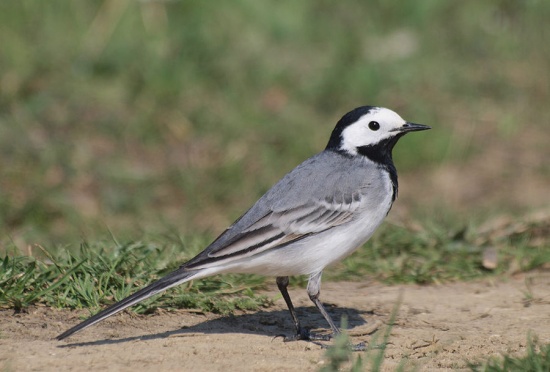- Motacilla alba
Includes: Black-backed Wagtail; Amur Wagtail; Himalayan Wagtail
Identification
16.5–19 cm. Nominate subspecies in spring plumage is grey above with two white wingbars and white edgings to several feather tracts and white below (including relatively clean flanks), it has a white face, black cap and black throat; male has sharp demarkation of cap versus mantle, female diffuse.
In winter, the black in the throat area is reduced to a relatively narrow band, and the contrast on the upperside is reduced to the extent that the female may completely lack the black cap.
Juvenile plumage can be extremely weakly marked, but soon becomes first winter, which is similar to a less contrasting winter female; however, the head especially can look yellowish.
A thread discussing the separation of White and Pied Wagtails.
Variation among subspecies is large; for descriptive notes on other subspecies see the taxonomy section.
Distribution
Widespread and abundant from Iceland, northern Norway and Novaya Zemlya south to the north Mediterranean coast and North-West Africa. In the Mediterranean breeds on Sicily and Crete, irregularly on Sardinia and Cyprus. Continental race alba is a rare breeder in Britain.
Eastern subspecies breed in Siberia, Japan, Korea, China and the Himalayas.
A summer visitor to the north and east, resident elsewhere. Widespread throughout southern Europe and around the Mediterranean in winter with some migrants wintering in tropical Africa and Asia.
Vagrants recorded north to Bear Island, Jan Mayen and Svalbard and south to the Azores, Madeira and Cape Verde Islands.
Taxonomy
There were eight subspecies accepted by Sibley-Monroe; alba, yarrellii, subpersonata, persica, dukhunensis, personata, baicalensis and ocularis, Clements accepts eleven (adding lugens, leucopsis and alboides).
Subspecies: the nominate alba occurs over the greater part of Europe and Turkey.
M.a.yarrellii is found in the British Isles and coastal North-Western Europe, differs from nominate in having a longer tail, black rather than grey back and dark dusky flanks; female often have grey back but of a darker coloration than alba; other plumages also similar to alba but with darker tones especially on back, flanks and rump.
M.a. dukhunensis from southern Russia and the Caucasus has paler back than alba and broader white markings on wings.
East Iranian race personata winters in Iraq, has head and breast black with white forehead and mask around eye much smaller than at alba, recorded as a vagrant in Germany.
West and central Iranian persica, also winters in Iraq, is perhaps not a valid race, intermediate between personata and either alba or dukhunensis.
Moroccan birds of race subpersonata have head and breast black with white forehead, and side of head a complex pattern of black and white and white spot on the sides of neck; this race has been recorded as a vagrant in France.
Lugens (black above with white wings) is sometimes accepted as full species (Black-backed Wagtail) and is found in eastern Siberia, Korea and Japan.
Leucopsis and alboides are part of this complex and breed further south. Some split them as Himalayan Wagtail (Motacilla alboides also known as Hodgson's Wagtail) and Amur Wagtail (Motacilla leucopsis) from Black-backed Wagtail.
Habitat
Open areas with some vegetation from Arctic regions and high mountains to semi-deserts and sea-coasts. Usually beside freshwater including ditches, streams, rivers and from pools up to the largest lakes and reservoirs. Also occurs away from water on farmland, frequently in farmyards and in town parks and gardens. Often forms large roosts in winter.
Behaviour
Can be seen throughout year, some North-South migration takes place.
Flight
Markedly undulating flight.
Breeding
The nest is a grass cup in hole or crevice and can be found in a bank, cliff, woodpile or shed. The clutch consists of 5 or 6 whitish eggs speckled with grey. They are incubated for about 2 weeks and fledge a further 2 weeks later. There may be 2 or 3 broods in the season which runs from March to September.
Diet
Can be seen scuttling around after insects and larvae.
References
- Birdwatching
Recommended Citation
- BirdForum Opus contributors. (2024) White Wagtail. In: BirdForum, the forum for wild birds and birding. Retrieved 4 May 2024 from https://www.birdforum.net/opus/White_Wagtail
Vocalisation
Strong Tchizick in flight
<flashmp3>Motacilla alba (song).mp3</flashmp3>
Listen in an external program
External Links
This link searches for videos of Pied Wagtail







